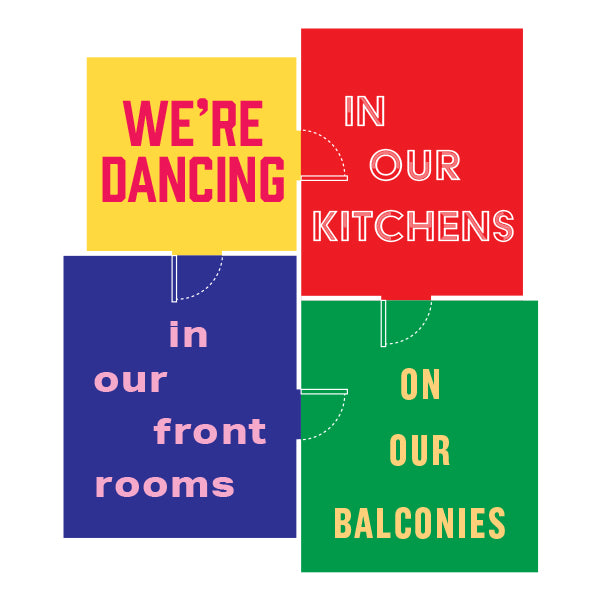During the UK's first coronavirus lockdown in 2020 we invited our friend the author Emma Warren to submit an article that responded to the theme of Isolation Nation for a group exhibition. The result had us (literally) dancing in our kitchen. After you've read the article scroll down for the accompanying spotify playlist.
This article was first published on Dorothy's blog in April 2020 and then was published in Dorothy's Studio Stories Magazine (Issue No. 1) in Autumn 2021.
DANCING AT HOME
−Words by Emma Warren
Late last year, before any of us had heard of coronavirus, Robert Gallagher DIY-published a slim hand-printed collection of poetry titled The Dancefloors of England. He spent years as a dancer, clubber and frontman of various musical iterations, including acid-jazz crew Galliano. His book surfaced a lifetime of synthesised observation and feeling about our collective relationship with dancing and the dancefloor. The opening poem 'The Mighty Cities Built From Sound’ feels especially right for now.
that was
there
last night
In the mighty cities
built
from
sound
has crumbled
as gossamer
rubble
Through the morning
as whistles
So for the moment, the dancefloor has moved indoors. We aren’t dancing together at weddings or family parties or gigs. We’re dancing in our kitchens, in our front rooms and on our balconies – or at least, I am. Actually, I’ve been doing this a while. I had been working at home for years pre-pandemic so I was well versed in the rejuvenating powers of a quick kitchen skank. Crank up the volume, blare out some General Levy or some Manu Dibango, dance it up, then head back to the laptop grind.
Our new world dancing at home is helped by the masses of DJ streams which have been bringing twenty-somethings back onto Facebook, and which have been making DJs front rooms into an extension of Boiler Room, albeit one that’s a bit sparsely attended.
Zezi Ifore is a broadcaster with a show on NTS Radio, founder of arts platform and long-running party Palm Wine Club and is a person with years of the dance under her belt. In the first week of the lock down, she tuned into London DJ Martelo who did a stream from his house. “There weren’t loads of us watching, maybe 50 of us, but it was amazing. It was proper community. It was a mix of his friends and people who went to a legendary night called YoYo, that he played at regularly back in the day. Basically we were re-enacting the club, like virtual role play: ‘I’m going to the bar, who wants any shots?’ Everyone was playing out the dance in the comments.”
“The medium doesn’t really matter,” she says. "It doesn’t matter that we’re not in the room because the connection is strong.”
My friend Kevin Braddock has responded to lockdown by dancing more. He’s the author of two books and a set of practice cards on the subject of recovering from anxiety and depression and has been making regular videos for the last few years. When the pandemic started, he responded with a series of clips titled Dancing Against Depression.
“It started because one of the practice cards says to dance for ten minutes to three songs,” he says. “It’s a very simple trick – serotonin is at its lowest first thing in the morning so if you get up and start moving around it gets it flowing. It’s just a habit I got into, of putting on some music in the morning and bopping around for a bit.”
So far, he’s danced his way through some northern soul, The Stone Roses ‘Fools Gold’, 1990s Berlin techno classic ‘Phylyps Trak’ and Massive Attack’s ‘Five Man Army’. He was filming the latter in a deserted car park on the Welsh borders at night when he was asked to go home by a local police patrol – which made it into the edit and gave him a good opportunity to remind his viewers to #stayathome.
“It’s just me being unselfconscious and dancing badly and there’s something very charming about that. Dancing can be a very self-conscious thing and I’m a very anxious and self-conscious person so it’s a way to dismantle that, and to let it go. To be expressive. That’s what dancing is, expressing yourself, and there’s no right or wrong way of doing it, is there? There’s a very simple causal link between dancing and not being depressed.”
Before the virus, I’d begun working on a book about dancing. As part of my research I’d started filming myself dancing in the morning so I could start to answer a question I’d been asking my interviewees: what’s in your moves and where do they come from?
Watching myself through the screen of my phone I noticed a few things. I get into the zone very quickly. Something funny happens to my eyes when I’m dancing. I also began to see where my moves come from. If I unpick it, they appear to combine elements of 1980s formation dancing, a basic two step with a touch of reggae skank. I see a few moves picked up in contemporary dance class and I see a general reserve, which sometimes blows open into dips and swirls and attempts at footwork – which generally result in my losing the flow temporarily. It isn’t pretty, but it is enjoyable.
Those of who know what it’s like to get into a communal flow on the dancefloor or at a dance class or even with friends and family at a wedding know that it isn’t necessarily about keeping your face nice. Musicians pretty quickly move into what I call ‘drummer face’ which is a kind of mild, transcendent gurn, an otherworldly look in which the person is differently present. I look the same in my home-made dance videos: slightly gone. I don’t care as much.
I get the feeling that dancing at home is the same. Under lockdown, we care less, whether we’re dyed in the wool dancefloor people or if we haven’t really been dancing since youth club. We don’t mind being slightly gone. The act of moving to music is more important than the potential embarrassment of not being good enough. There are endless examples of DIY dance videos online, like the two young men creating a Tik Tok outside my local park gates. It works across the talent spectrum: I’ve been dancing through my flat every day, side-stepping instead of walking, and slip-sliding across the wooden floor to Chicago house, Eighties funk and selected OutKast tunes. The fun of moving and the giddy joy of a tiny moment of release works wonders against the pervasive, airborne stresses that surround us all, worldwide, at the moment.
It’s going to be a challenge to replicate or remake the community and communication that exists when we’re in physical proximity to each other, dancing together at weddings or clubs or family parties. But until the pandemic is over, dancing by ourselves is better than nothing. And it might be a whole lot better than nothing. It might be something. Because on the other side of this, humbled by the realities that have come crashing down around us, we in this country might start dancing more – and that’s got to be a good thing. Bring on the house parties, bring on the shebeens. Let’s dance.
If you enjoyed this article then you'll also like Emma's first book. Make Some Space: Tuning into Total Refreshment Centre available for £12 from Sweet Machine.
"A cultural history-cum-manifesto for creating musical communities in the 21st century, told through the story of one east London building and its development of a new jazz scene." Ammar Kalia, The Observer
Follow Emma Warren on Instagram


